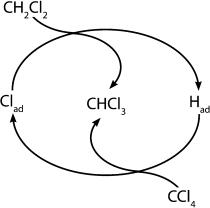|
Related Topics: |
|
Current News |
|
Chemistry A to Z |
|
About Internetchemistry |
|
- Imprint |
|
|
Fair Trade |
|
Because of its toxicity and the dangers involved in handling it, tetrachloromethane (carbon tetrachloride, CCl4) can no longer be used or produced in many countries. However, the processes used in the production of other chlorinated hydrocarbons, such as chloroform (trichloromethane, CHCl3), also produce CCl4 as a byproduct. What is the best way to get rid of this unwanted substance? A team headed by Bert M. Weckhuysen at the University of Utrecht (Netherlands) has now found an interesting new approach that may lead to effective recycling. As the researchers reported in the journal Angewandte Chemie, a lanthanum chloride catalyst induces CCl4 and its reaction partner dichloromethane (CH2Cl2) to exchange one chlorine atom for a hydrogen atom, forming nearly 100 % of the desired CHCl3. |
|
In order to increase the catalyst surface, lanthanum chloride (LaCl3) was deposited onto carbon nanofiber supports. This results in a highly active, selective, and stable catalyst to facilitate the hydrogen–chlorine exchange between CCl4 and CH2Cl2. “Computer calculations suggest,” says Weckhuysen, “that the mechanism occurs by way of two separate hydrogen–chlorine exchange reactions.” It appears that the surface of the LaCl3 catalyst contains not only the terminal chlorine atoms of the crystal lattice, but also other weakly adsorbed species. CH2Cl2 swaps one of its hydrogen atoms for one such weakly bound chlorine atom. It leaves behind the hydrogen atom, which is in turn weakly adsorbed to the catalyst surface. This hydrogen atom can be taken up by CCl4, which in turn leaves one of its chlorine atoms behind on the catalyst surface. Both of these reaction steps produce chloroform exclusively; no byproducts come into play. This new catalytic reaction is astonishing in that it was previously assumed that the presence of oxygen - either in the gas phase or bound to the crystal lattice of the catalyst - is required for such reactions. Says Weckhuysen: “We are reporting for the first time a lanthanum-based catalyst material that can activate both C-H and C-Cl bonds in the absence of oxygen.” |
|
|
|
|
Related topics - search form: |
|
|
